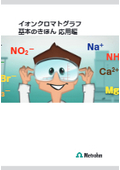Technical Data: Basics of Ion Chromatography - Anion Analysis Edition
IC: Ion Chromatography A beginner-friendly technical booklet that clearly explains the analysis of anions using ion chromatography!
Content 1) Anion Analysis and Official Methods Content 2) Basic Operations and General Precautions for Anion Analysis Content 3) Measurement Examples of Anion Analysis
basic information
The purpose for which ion chromatography is used is 60-70% anion analysis. The reason for this is clear: cation analysis, especially for alkali metals and alkaline earth ions, can be easily and accurately measured using atomic absorption spectrometry (AAS) or inductively coupled plasma atomic emission spectrometry (ICP-AES). Ammonium ions can also be easily measured using the indophenol blue spectrophotometric method. However, this is not the case for anions. Even with AAS or ICP-AES, it is not possible to measure halogen ions. The same goes for ions such as nitrate, nitrite, phosphate, and sulfate, which cannot be detected or have low sensitivity, making actual measurement impossible. Fluoride ions, nitrate/nitrite ions, and phosphate ions can be measured with relatively high sensitivity using lanthanum arsenazo complex spectrophotometry, copper/cadmium reduction-naphthyl ethylenediamine spectrophotometry, and molybdenum blue spectrophotometry, respectively. However, these methods are quite cumbersome and take a considerable amount of time for analysis, so they cannot necessarily be considered convenient methods. As for chloride ions and sulfate ions, there are no good methods at all, and silver nitrate titration or gravimetric methods are often used.
Price range
Delivery Time
Model number/Brand name
Basics of Ion Chromatography: Anion Analysis Edition
Applications/Examples of results
The booklet is available for free download.
catalog(15)
Download All Catalogs






Ion Chromatograph IC starting from 2.7 million yen! 2023 Academia Campaign
Recommended products
Distributors
Metrom AG, based in Herisau, Switzerland, is a leading company specializing in ion analysis with over 70 years of history. It provides products and services in more than 140 countries worldwide. Based on Swiss technology developed over many years, the equipment comes with a 3-year warranty.


























































